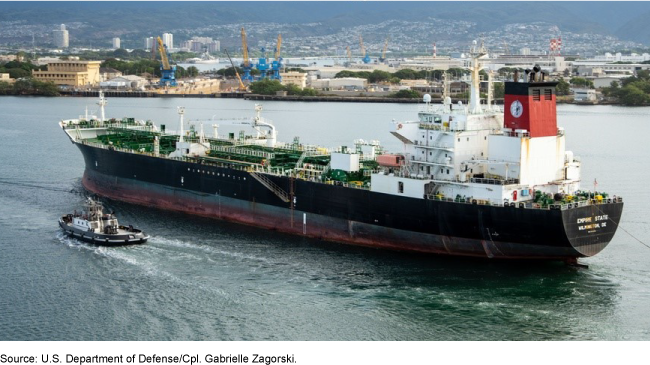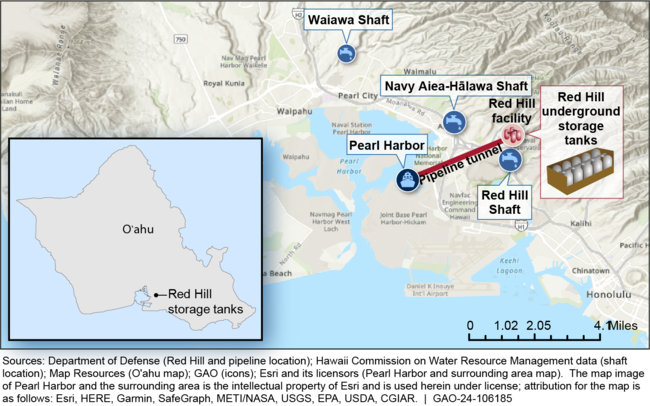Environmental Cleanup: DOD Should Communicate Future Costs for Red Hill Remediation and Closure
Fast Facts
In November 2021, a large fuel spill at the Red Hill facility—part of a fuel storage system the Navy manages on O'ahu, Hawaii—contaminated portions of the surrounding area and a nearby well.
DOD plans to close the facility but cleaning up the contamination could take decades. Yet the agency's reports to Congress about the work haven't included cost estimates beyond FY 2024. As a result, Congress and the public don't have a complete picture of the substantial costs DOD is likely to incur for the site in the future.
We recommended that DOD clearly identify its anticipated costs for the Red Hill site in its reports and materials for Congress.
A tanker ship arriving in O’ahu to help remove fuel from the Red Hill facility in October, 2023.

Highlights
What GAO Found
The Department of Defense (DOD) responded to fuel and other releases that accidentally occurred from 2014 through 2022 at the Red Hill Bulk Fuel Facility on O‘ahu, Hawaii, by containing pollutants and taking abatement measures. Since then, DOD has developed and begun implementing a defueling plan and developed an initial closure plan for the tank system. However, as of August 2023, DOD had not finished a site investigation or remediation plan. DOD plans to close the tanks in place and complete its site investigation by the end of fiscal year 2027, but comprehensive remediation of the site could take decades.
Timeline of Major Releases during 2014 through 2022

DOD faces three key challenges in its efforts to defuel, remediate, and close Red Hill: (1) obtaining regulatory approval from the Hawaii Department of Health and the Environmental Protection Agency (EPA), (2) assessing contamination amid the site's unique geologic complexity, and (3) gaining trust and working with community stakeholders. Red Hill's proximity to several drinking water wells in the Honolulu Hawaii area compounds the unique geologic complexity.
Map of Red Hill Bulk Fuel Storage Facility, Nearby Navy Drinking Water Wells (Shafts), and the Surrounding Area

In response to challenges, DOD has taken several actions, including developing a joint integrated master schedule to prioritize key deliverables for defueling tasks and align them with state officials' priorities and working with EPA to make groundwater well monitoring data more easily available to the public.
DOD and its components stated that the accidental 2021 Red Hill fuel release affected their fiscal year 2022 financial statements in a variety of ways. DOD concluded that while the future outflow of resources to clean up and close Red Hill was probable, an amount was not reasonably estimable given the lack of a completed remedial investigation and experience with a similar site. Accounting standards require that if a future outflow or other sacrifice of resources is probable but not reasonably estimable, an entity should not record an environmental liability in the financial statements. In such cases, an entity should disclose certain information about the event within the notes of its financial statements. Accordingly, DOD and relevant DOD components disclosed information in their fiscal year 2022 financial statements, including a description of the Red Hill event and its effect.
While federal accounting standards require certain environmental liabilities and contingencies to be reported or disclosed in federal agencies' financial statements, other future costs not included in financial statements can be communicated to Congress in budget materials. The financial statement estimates do not represent the total federal fiscal exposure or the total amount that the federal government may have to pay. In addition to the liabilities and contingencies in financial statements, there are other components that, when combined, account for total federal fiscal exposure. These include costs to clean up and close known sites that are not currently reasonably estimable, and unknown cleanup and closure costs that may be identified in the future as remedial investigations are completed and closure plans are approved.
DOD had not, as of the end of fiscal year 2023, communicated information to Congress about total fiscal exposures for anticipated Red Hill remediation activities for fiscal years 2025 and beyond. Specifically, DOD is aware of millions of dollars of costs that it is likely to incur as part of the Red Hill remediation and closure. It is also aware of numerous other costs for significant tasks that it cannot estimate at this time. Congress has appropriated at least $1.2 billion to DOD for activities related to improvement of infrastructure and defueling at Red Hill, and DOD has spent or plans to spend these funds. However, DOD's reports to Congress have not included projected cost estimates for fiscal year 2025 and beyond, which is the time frame during which DOD will likely incur substantial costs. Because these projected cost estimates have not been conveyed, Congress does not have information on total estimated remediation and closure costs in budget materials. With this financial exposure information, Congress would be better equipped to make decisions regarding funding remediation and closure activities.
Why GAO Did This Study
In November 2021, approximately 21,000 gallons of fuel was accidentally released from Red Hill, part of a fuel storage system the Navy manages. The Navy was unable to recover about 5,500 gallons, which ultimately contaminated portions of the surrounding area and a nearby well that supplied drinking water to about 93,000 service members and civilians. The November 2021 spill was not the first accidental release at Red Hill. Over the last decade, this facility, which supplied various types of fuel to DOD resources in the Pacific, experienced several other spills that DOD could not fully recover. In March 2022, the Secretary of Defense announced that DOD planned to defuel and permanently close the facility and remediate the site.
House Report 117-397 includes a provision for GAO to review DOD's efforts to remediate Red Hill and report on liabilities and costs to clean up and close the facility. This report (1) describes actions DOD is taking to defuel and close the Red Hill facility, including remediating the site, and the challenges it faces in doing so; (2) assesses to what extent DOD estimated and recorded environmental and contingent liabilities for the November 2021 Red Hill fuel release in its financial statements; and (3) assesses to what extent DOD estimated and reported to Congress on the total fiscal exposure to defuel and close Red Hill. GAO visited the Red Hill site, interviewed DOD regulatory and other officials, and evaluated financial and regulatory documentation. Specifically, GAO met with officials from EPA, the Hawaii Department of Health, the Honolulu Board of Water Supply, the Hawaii Commission on Water Resource Management, and five selected community groups.
Recommendations
GAO recommends that DOD expand the information available to Congress on the anticipated amount of fiscal exposure for defueling, remediation, and closure of the site in supplemental reports or other budget materials. DOD agreed with the recommendation and discussed planned implementation steps.
Recommendations for Executive Action
| Agency Affected | Recommendation | Status |
|---|---|---|
| Department of Defense | The Secretary of Defense should expand the information available to Congress regarding the agency's fiscal exposure related to the Red Hill Bulk Fuel Facility by clearly identifying anticipated costs for defueling, remediating, and closing Red Hill in supplemental reports or other budget materials, updating the information as more is learned. (Recommendation 1) |
In its comments on our draft report, DOD agreed with this recommendation and discussed planned implementation steps. Specifically, as planned site assessments are completed and closure and remediation plans receive regulatory approval, estimable cost projections will be incorporated and communicated through the normal budget process. The action that DOD described, if implemented effectively, would address our recommendation.
|
